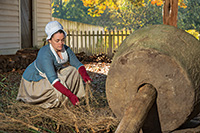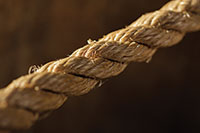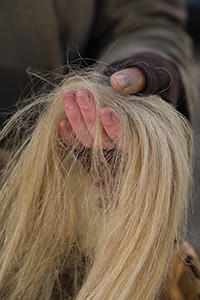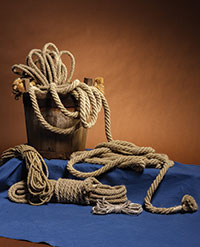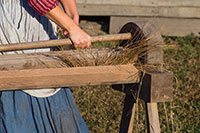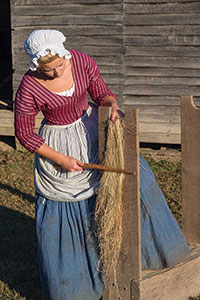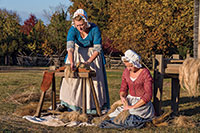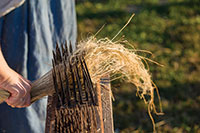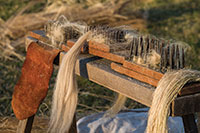Hemp & Flax in Colonial America
by Ben Swenson
Learn more
Colonial planters gushed of the crop's promise. Col. William Byrd II called its cultivation “the Darling of all my Projects.” Robert Beverley predicted the plant “will be of the greatest consequence to us.” Thomas Jefferson directed that “an acre of the best ground” at his Poplar Forest estate be kept for a permanent patch of the stuff. The object of their affection was not tobacco, the ubiquitous “Indian weed” responsible for the fortunes and failings of so many 18th-century Americans. This was a weed of a different sort, one that would likewise collect healthy shares of praise and scorn.
Hemp was well known to colonial Americans, but not for the same reason the plant would make headlines more than two centuries later. Today's debate, which centers on the legalization of marijuana, is not the first time that cannabis has captured the attention of the nation. For thousands of 18th-century Americans, from humble, middling farmers to large planters like Byrd, Beverley and Jefferson, the ability of cannabis to intoxicate was incidental. They were instead interested in a trait they considered far more valuable.
Hemp fibers are exceptionally strong and durable, and in an era before science could do better, that made this a commodity worth growing.
Hemp was among the first plants humans cultivated. Ancient Chinese pottery bearing impressions from hemp rope suggest its use 5,000 years ago and possibly more than twice that long. Credit for this long-term relationship belongs to hemp's many applications: thread, cordage, cloth, paper, food and, yes, intoxication.
When humans took to the seas, every sizable vessel required lines and sailcloth capable of withstanding all that open water could muster. Hemp proved the best fit. Historian Martin Booth estimated the English fleet that defeated the Spanish Armada in 1588 donned 10,000 acres of cultivated hemp. The emerging prominence of the English navy was the chief reason English farmers and later their American cousins were required to devote a share of their acreage to hemp. The Virginia Assembly in 1632 ordered “that every planter as soone as he may, provide seede of flaxe and hempe and sowe the same.”
Flax too created useful filament, but fibers from flax — a shorter, more slender plant — tended to be finer and they were usually made into clothes rather than cordage. Hemp was generally preferred for cordage, though the two products were often used interchangeably and sometimes even woven together into the same textile.
Hemp had the added advantage of returning at least twice as much yield in fibers per acre than flax under ideal growing and processing conditions. Farmers cultivated hemp throughout the American colonies, from the southern reaches of North America to New England and Canada, since it grows in all but the coldest climates. But in the 18th century, Virginians and Marylanders grew the most.
There was an indigenous species known to Native Americans called Indian hemp (Apocynum cannabinum), but the cannabis most often cultivated in the colonies was an introduced species, Cannabis sativa.
Along with its long, sturdy fibers, cannabis has another remarkable trait: it synthesizes a chemical called delta-9-tetrahydrocannabinol, or THC. THC is a psychoactive compound found at highest levels in a resin cannabis produces. Cannabis has separate male and female organs on different plants, and the unfertilized flowers of hemp's female plants contain the most resin. By themselves, the female flowers are what we today call marijuana. The resin can also be collected and formed into cakes known as hashish. Smoking or eating marijuana or hashish induces a hallucinogenic high.
Ancient records refer to people partaking in ritualistic and recreational intoxication from hemp at least 2,600 years ago. People also ingested hemp as a painkiller capable of treating the symptoms of numerous debilitating conditions including rheumatism and gout.
Though the hallucinogenic properties were well known by the 18th century, there's no evidence to suggest that colonial Americans were taking advantage of this mind-altering quirk of the hemp they grew.
For starters, farmers sowed their hemp crop in tight patches, creating individual plants that were tall by design. Byrd boasted that his hemp was “twice as long as that which comes from the East Country.” A traveler to Virginia's Shenandoah Valley observed hemp that was 14 feet tall. Hemp in tight clusters bears few branches, and therefore lacks the profusion of female flowers where the concentration of THC is the greatest.
What's more, no sources from 18th-century America refer to the ingestion of what we call today marijuana or hashish. There have been attempts to interpret some hemp references to suggest that obtaining a high was common, but those explanations fall flat when placed in the proper context.
For instance, John Adams (writing incognito as Humphrey Ploughjogger) once penned that “we shall by and by want a world of hemp more for our own consumshon” and George Washington lamented not separating his male and female hemp plants.
Aha! Founding smokers, right? Not so fast. Adams's quote actually was a satirical take on hanging political dissidents by hemp rope, while Washington's was an acknowledgment of an agricultural slip up, as hemp gone to seed (after the male pollen fertilizes the female flower) produces coarser, less valuable fibers.
Many 18th-century Americans enjoyed recreational intoxication now and again, but they consumed alcohol for that, not THC. Neither was hemp used all that much for medicine; the seeds (which contain no appreciable amounts of THC) were boiled in milk to treat coughs, but if ailing colonists needed a potent painkiller, heavier ammunition, notably opium, was available without much effort.
Even if early Americans were well aware of hemp's psychoactive and medicinal qualities, those features were hardly a priority. Clothes, ropes, bed ticking and sacks were more immediate concerns — all the workaday hardware that enabled a decent living in a pre-industrial world. Hemp was good to have around for the manufacture of these items, but cash crops, particularly tobacco in Tidewater Virginia and Maryland, remained the mainstays.
A frustrating feature of 18th-century agriculture was price fluctuations that could leave yeomen in the red. The hemp market did not suffer gluts like tobacco. “I am so out of Humour with Tobacco (which is made in too great a Quantity) that I have turn'd great part of my force towards Hemp,” wrote Byrd.
Jefferson noted that hemp “is abundantly productive and will grow forever on the same spot,” unlike tobacco, which depletes soil nutrients. Markets for hemp abounded, too. Not only could it be made into textiles for one's own use, but there were so many willing buyers in northeastern cities that Americans exported little to England.
Still, the long transformation from tiny seed to finished product was no small task. According to a 1799 treatise on hemp production, “two autumnal plowings; and the like plowings with harrowings in the next spring” were best practices for the soil preparation alone. Seeds were scattered by hand after which shoots would “rapidly cover and shelter the whole ground,” akin to the spacing on a modern stand of bamboo.
After 13 weeks or so, the plants had to be cut or pulled from the ground and tied in large bundles to dry. Retting or rotting occurred by immersing the stalks in water or by allowing natural moisture, in the form of rain or dew, to fall on them, loosening the useful strands from the woody bark and interior. After another period of drying, laborers used a hemp brake, a wooden tool that is shaped like the jaws of a crocodile, to crack and separate the unwanted flakes of waste from the long fibers.
Breaking was a repetitive, tiring task. For all his praise of hemp, Byrd noted “one difficulty that discomfits me a little, an[d] that is the great Labour it requires in the breaking it.” Said Jefferson: “[B]reaking and beating it, which has always been done by hand, is so slow, so laborious, and so much complained of by our laborers.” This was after he had invented his own hemp brake in an effort to ease the chore.
Some of the refuse fell free from the lint during breaking but not all. The fibers had to be scutched (beaten and scraped), then heckled (combed), to shed the hangers-on still entangled in the long strands. Only then could the hemp be spun into thread and twisted or woven into cordage or textiles.
The difficulty of processing hemp did not deter its cultivation. In the spring of 1729, Byrd sowed 90 bushels of hemp seed, optimistic that a bumper crop would result. That was enough for 36 acres or more. Most Tidewater planters grew a fraction of that, keeping much of their acreage in tobacco and other cash crops.
In Virginia's Piedmont and Shenandoah Valley regions, where tobacco did not grow so well, hemp became a staple. By the middle of the 18th century, Virginians had 12,000 acres cultivated in hemp, more than a quarter of the 45,000 acres they had in tobacco.
As the relationship between Britain and the American colonies soured, hemp gained favor to compensate for shortages caused by boycotts of British imports. Homespun clothing, including that made out of hemp, became a hallmark of the American cause. The Virginia Gazette in April 1767 printed front-page instructions for growing hemp. The freeholders of Henrico County, Va., were among the chorus of voices who resolved in 1774 “that the raising of Sheep, Hemp, and Flax ought to be encouraged,” and “that to be clothed in Manufactures fabricated in the Colony ought to be considered as a Badge of Distinction and Respect, and true Patriotism.”
Virginians were permitted to pay taxes in hemp, along with other cash crops. Financial incentives like this had precedent; both the Virginia Assembly and the British Parliament provided bounties for growing hemp throughout the 17th and 18th centuries in an effort to cut reliance on foreign imports, especially from Russia, where the quantity and quality of the crop were unmatched the world over.
With the onset of fighting in 1775, Americans' need for hemp became urgent. While hemp products were useful for ground troops, naval forces were paralyzed without them. There were 11 state-sponsored fleets during the American Revolution, as well as the Continental Navy, and every single ship needed ropes and sails. A single vessel in the Virginia Navy called the “Brigantine Liberty,” for example, required more than two miles of cordage.
The surge in demand for hemp caused prices to skyrocket, in some cases to three times the peacetime averages, and many farmers weren't going to let that opportunity pass. Wartime Virginia had at least 18 rope walks — industrial operations devoted to the manufacture of cordage. Three were government-sponsored and staffed by official commissioners authorized to purchase hemp from farmers with public money.
Their job was not easy. “I have had but little success in Purchasing hemp,” wrote Alexander Sinclair from Staunton, Va., back to his boss at the Public Rope Walk at Warwick in 1779. “[T]he People are asking three hundred pounds [per] Ton delivered here for it, which is so far above the usual price.”
During the American Revolution, Virginia had at least four hemp mills, which facilitated some of the hard work involved in processing. One was at the Williamsburg Manufactory, an operation charged with turning raw materials into finished textiles. In a July 1777 advertisement in The Virginia Gazette, the Williamsburg Manufactory advertised for sale at an upcoming auction “about four hundred Yards of Hempen Linen.” The volume of that single transaction equivalent to the amount needed for approximately 20 tents for the army — suggests farmers were growing a large amount of hemp nearby. Long-distance transport of the unprocessed stalks, which were much heavier than the end product, did not make economic sense.
By the end of the American Revolution, Virginia produced 5,000 tons of hemp annually – some 20,000 acres worth – but when the gunshots abated, so too did the pressing need for this versatile crop. Demand that lingered was satisfied in greener pastures settlers discovered in Kentucky and Tennessee, and with foreign imports. Hemp flourished as a domestic cash crop through World War II and beyond, but the plant's utility was no match for advocates of temperance.
Throughout the 20th century, individual states and the federal government criminalized cannabis. The harmful effects of the plant's ability to intoxicate were too great a threat, its useful products notwithstanding. There were, after all, synthetic fibers capable of filling the role hemp once did.
In recent decades many Americans have been rethinking the nation's relationship to hemp. Though hemp's legacy in colonial America largely hides in the shadow of marijuana's prohibition, traces still exist at Colonial Williamsburg. Beside the Taliaferro-Cole Shop, where Colonial Williamsburg's weavers ply their trade, is a large, fluted stone. This is an old hemp mill stone, recovered by archaeologists from the banks of Queens Creek nearby, and it once turned at the Williamsburg Manufactory. To this tool millers hitched a draft animal that walked in endless circles, breaking hemp, liberating strong fibers that held together a new nation.


